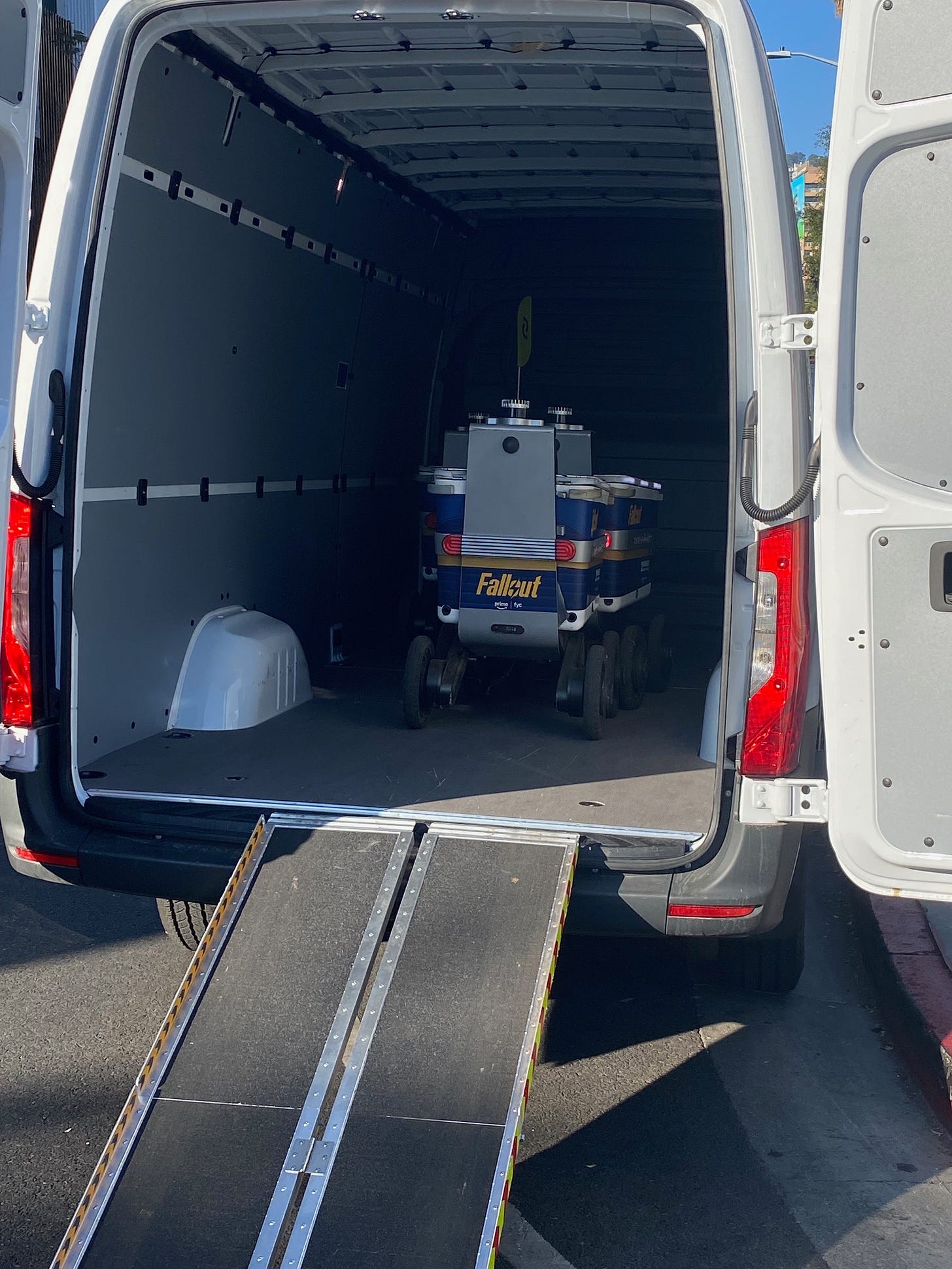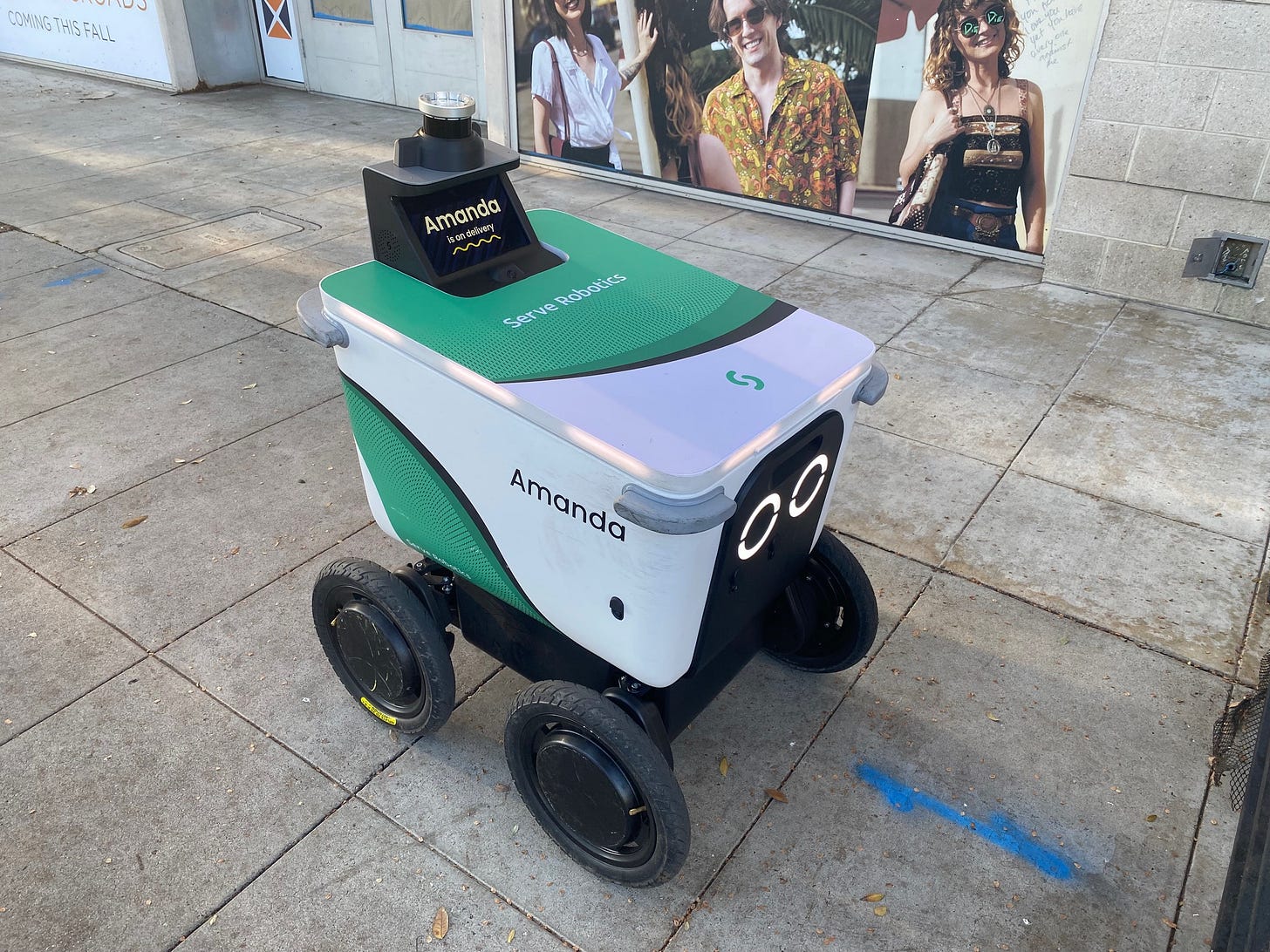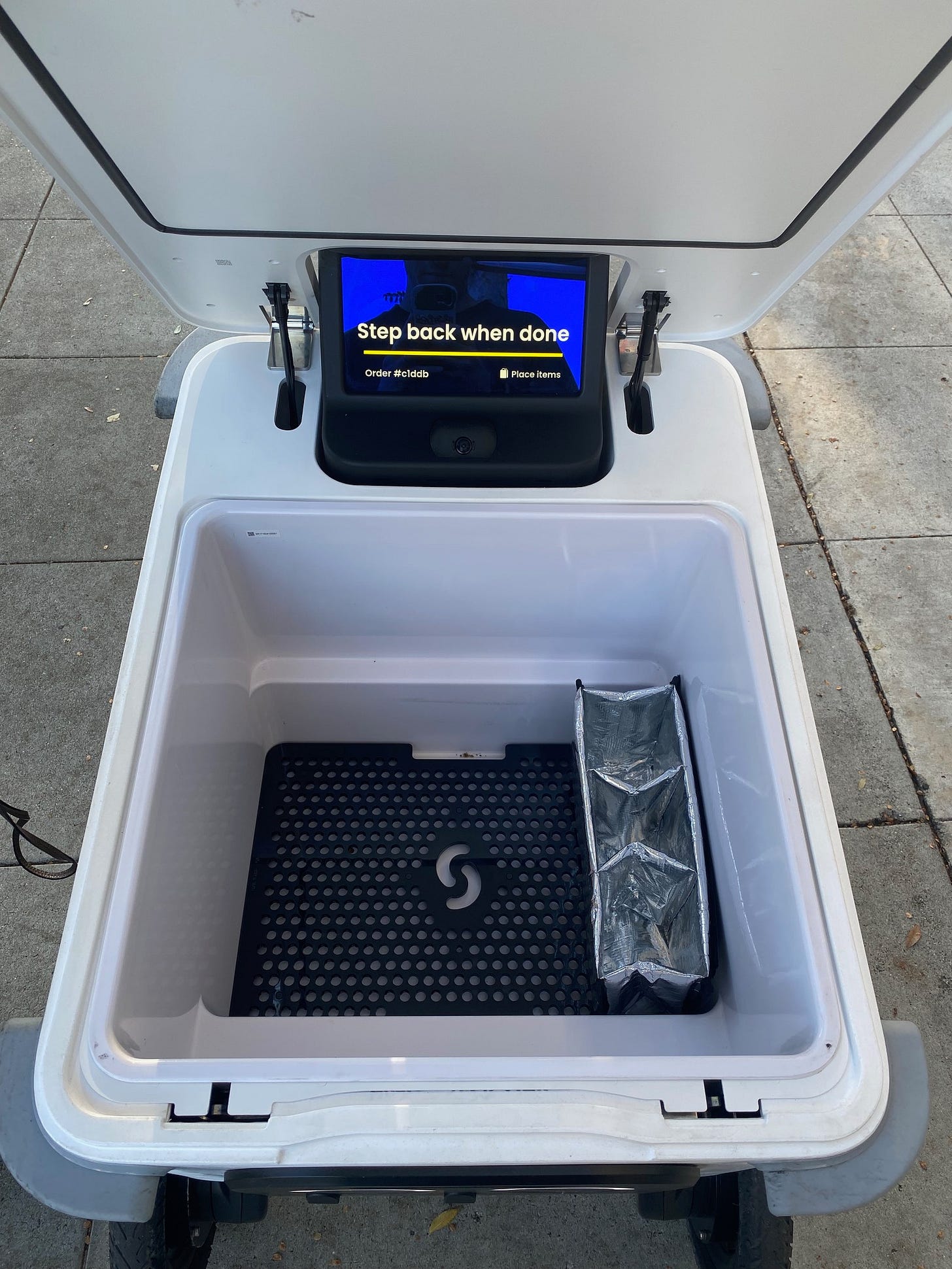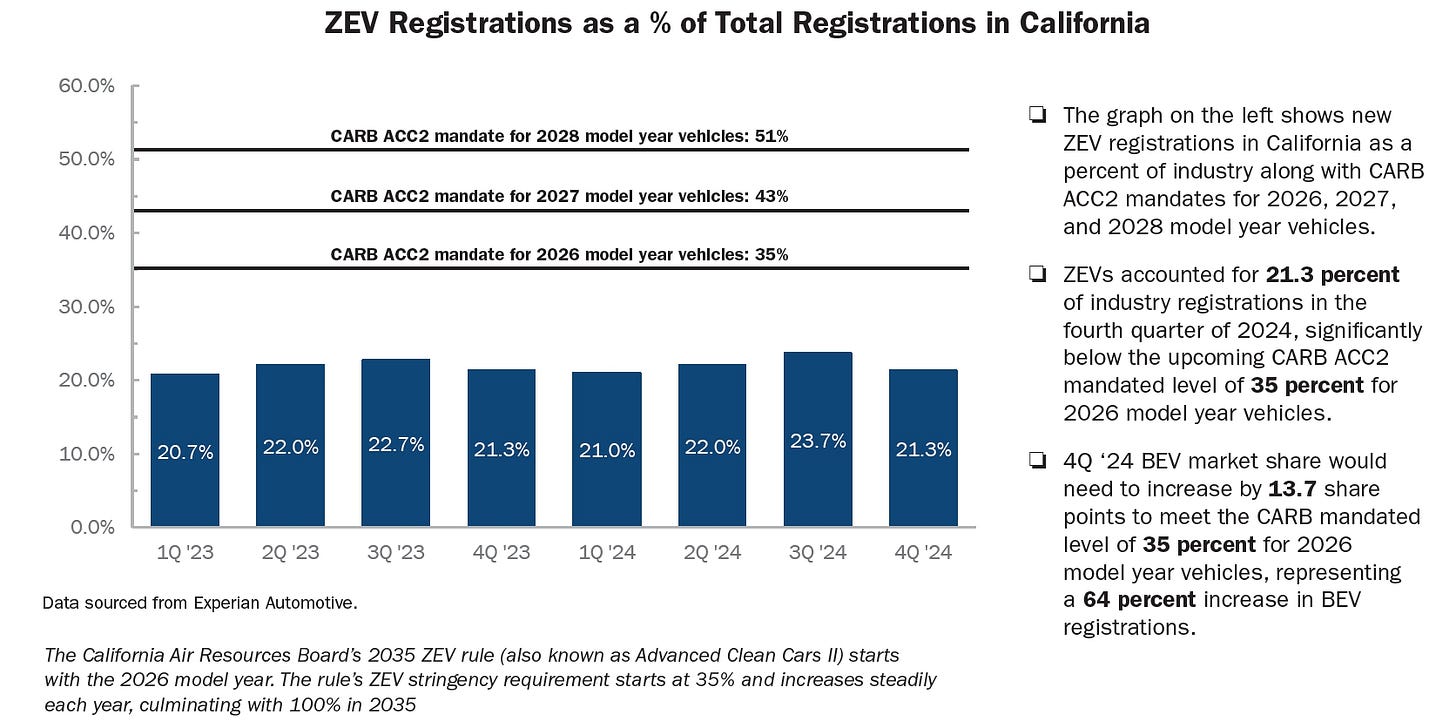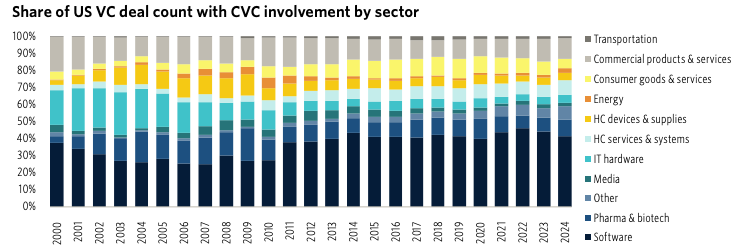Two Days Left to Save on the "Best ROI" Mobility & Delivery Event
Serve's new robots, ZEV sales stall, Bolt heads to America
You have just TWO DAYS LEFT to score $195 tickets to Curbivore — saving you hundreds on our renowned gathering of mobility, delivery and curbside leaders.
Industry insiders agree! In the words of Hantz Fevry, Founder & CEO of location intelligence app Stoovo, “Curbivore has the best ROI of any event we attend. We formed a valuable partnership with Walmart after meeting them at the conference.”
Going On Delivery With Serve's Third Generation Hardware
It’s a busy Friday afternoon in West Hollywood, and the streets and sidewalks teem with life: pedestrians and bicyclists cruise down Santa Monica boulevard, joggers are turning the steep intersecting streets into their exercise grounds, busses and autonomous Waymos are filled with commuters wrapping up their weeks. This busy urban scene is the perfect proving ground for the real star of today’s show: Serve Robotics’ new third generation sidewalk delivery robots.
As I first encounter a handful of Serves being unloaded out of a delivery van, I think “these look awfully familiar.” I’m on site to kick the tires on new hardware — sleeker, faster, almost twice the operating range per charge — but the bots being disgorged from this tired Chevy look like they’ve been battling the mean streets of SoCal for years. Then I see it, like a distant mirage, a new 3rd Generation robot, descending from the hills above.
While the robot is being remotely monitored from Serve’s local operations center, on this trip it’s also accompanied by Andy Perry, Serve’s Product Manager, who has been with the company since it started as a skunkworks project within Postmates. He talks me through some of the other improvements to the model, internally known as version 1.7.
For starters, it’s got a redesigned drive train and suspension, plus independent front and rear axle steering, making it easier for the robot to hop and pop over Southern California’s crappy curbs. The acceleration and speed have improved, but so have the braking power and stop distance (by 40%), to keep things safe. Also keeping things secure is an improved Lidar with higher resolution, along with a repositioned Intel RealSense system, and RGB camera sensors. Another big improvement is the bot’s ability to handle inclement weather, meaning not only changes to the tires but also a blower over the cameras to clear the lenses; let’s just say this hints at Serve’s ambitious plans to enter new markets over the next few years.
Dinner Is Delivered
But what’s the 1.7 like in action? Our friendly robot — she goes by Amanda — is called into service for the early dinner rush, and I follow along as the little machine crosses the street, obeying both traffic laws and earthlings’ customs. It stops in front of Fresh Corn Grill, and a worker leaves the restaurant’s counter to pop an order into the robot’s cooler-like belly. He quickly closes the lid, and the load-in is complete, taking no more than 45 seconds. And just as quickly, the robot starts off towards its hungry customer, zipping back down the street. In fact, this pint-sized delivery worker is going too quickly, I lose sight of it after it makes a quick turn down Huntley Drive; here’s hoping that food arrived not too jostled.
Anthony Armenta Joins as Chief Software and Data Officer
Afterwards, I catch up with Anthony Armenta, who just returned to Serve as the company’s Chief Software and Data Officer, after spending a few years leading hardware development at GM BrightDrop. He gets a bit more into the nitty gritty of the technical improvements. In terms of cost efficiency, he shares that “manufacturing costs have been halved compared to the previous generation by leveraging a global supply chain with final assembly in North America, making these robots more accessible for large-scale deployment.”
Read More — Including Photos & Tech Specs — at Ottomate News.
HOT INDUSTRY NEWS & GOSSIP
Cool curbs in Rain City: CurbIQ, SDOT and the OMF have teamed up to visualize all the curb uses and regulation near Seattle’s waterfront.
Startup ups: UVeye raises $191M for automated vehicle inspections. Rynse raises $5M for fleet management software. Waabi deepens Volvo partnership for AV trucking.
And startup downs: UK cargo bike logistics heavyweight Zedify has filed for bankruptcy, despite big customers like Zara and an infusion of cash last year. BlaBlaCar’s revenue fell last year due to French governmental issues. Cruise cuts workforce in half as GM pivots away from robotaxis.
Automakers down too: Nissan is walking away from its proposed tie-up with Honda, as it’s too proud to be a subsidiary; now it looks to be courting Foxconn. Ford’s stock has tanked despite strong profits, as the company projects weaker sales going ahead. Despite the monthlong reprieve, looming tariffs could push up car costs by $3k. Would an unintended consequence mean fewer dumb giant trucks and more pedestrians? And here in the Golden State, ZEV sales have stalled — time for lawmakers to put a heavy tax on ICE vehicles?
Invasion of the Europeans! Estonian mobility super app Bolt (formerly Taxify) is launching its first foray in the U.S., as it brings scooters to Washington, D.C. It’s branding them as “Hopp” to avoid confusion with another micromobility brand that used to go by Bolt and has since gone under. Maybe the Estonians can occupy D.C. for a bit?
Decongestion pricing: A new congestion pricing tracker shows that NYC’s new cordoned toll is measurably improving commute times. Meanwhile, pedestrian activity in the affected zones is up, which should be good news for overly worried local businesses.
We’re getting our butts kicked by Tunisia, f’ing Tunisia! Tunis, the North African city of about 600k (with another 2 million in the suburbs) just opened suburban rail line D, offering frequent electric rail service over an 8.2 mile route. The multi-line RFR system complements a six-line light rail network and a commuter rail line. I guess at least the long history of French colonization left a love for good infrastructure…
Going maximalist on de minimis provisions: Shein, Temu and AliExpress are in a tough position, as the end of de minimis exemptions means a costly and complicated importing exception for their formerly duty-free drop shipped goods. This might mean at least a brief reprieve from the surge of delivery truck traffic that’s accompanied their rise. Ever clever, Flexport already has a financing solution that might help smaller shippers ride out this new uncertainty.
A boon for corporate venture capital? Toyota Tsusho has appointed a new President — Ichiro Kashitani — who comes from the group’s CVC arm. This could spell more investments and deal-making from the mobility giant. CVC activity has blossomed in the past few years, although transportation remains one of the smaller sectors for the format.
Things fall apart: As the new administration continues its illegal assault on Federalism, it’s taken down access to a number of vital repositories of public data. Of particular interest to readers may be the loss of Census bureau boundary data and microdata, which are vital to understanding changes to our cities and transport systems.
A few good links: Circuit seeks Marketing Lead (cool job, but pay is a bit low…) Abundant Housing seeks Director of Organizing. Transit agencies look to add potties. Tell the City of LA to do better with its Measure HLA implementation. LA tech and biz execs launch fire aid non-profits. UPS cuts Amazon volume to improve profits.
Get your Curbivore tickets!
- Jonah Bliss & The Curbivore Crew



